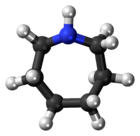|
Azepane
Azepane is the organic compound with the formula (CH2)6NH. It is a colorless liquid. A cyclic secondary amine, it is a precursor to several drugs and pesticides. It is produced by partial hydrogenolysis of hexamethylene diamine.[2] Like many amines, it reacts with carbon dioxide.[3] Azepane-containing drugsA variety of pharmaceutical drugs contain an azepane ring including bazedoxifene, cetiedil, glisoxepide, mecillinam, nabazenil, setastine, and tolazamide, among others. See alsoReferences
|
||||||||||||||||||||||||||||||||||||||||||||||||||||||

